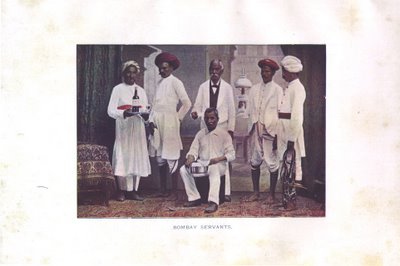
Native Servants
“It has been said, with some amount of truth, that natives of India make excellent servants, but one of the qualifying conditions lies in the necessity of knowing how to manage them. […] For while a man always robs you over the monthly bazaar account to the utmost of his ability, he may be above suspicion – but this is not to be regarded as a certainty – in the matter of money or valuables entrusted to his care.
The number of servants in various households differs to a great extent, but the smallest bachelor establishments usually find it necessary to employ at least five persons, of which the butler, or ‘bootliar’ as the native has it, is the chief. It is he whose proud privilege it is to go each morning to the bazaar […]. As it is a matter of impossibility for Europeans to ascertain the actual prices of things sold in the bazaar, these never remaining the same for two days together, it may be imagined that the daily statement purchases opens out a wide field for enterprise on the part of the butler, of which he is not slow to take the fullest advantage.
The marketings cannot be undertaken without the aid of a coolie […]. The cook has a mate, be the household ever so small […].it is necessary to employ a hamal – a gentleman whose chief duty would appear to be, if may be judged by his actions, to flick the dust from one part of the room to the other, to mix up the paper’s on one’s desk in extricable confusion, and removing certain books from their places, to carefully replace them, bottom uppermost. […] The work of the bearer, or dressing boy, is to lay out your clothes in the morning, to put the studs in your shirt […]. He waits upon you at the table and considers that this and the task previously detailed constitute a day’s labour sufficiently arduous for any one man.
The syce, or groom, is a necessity in most bungalows, despite the advent of the bicycle .[…] The centre figure is the cook, a Goanese, as is also the dressing-boy in his rear – beside him being the hamal, the butler completing the list.”
in Coleman, F. M., Typical Pictures of Indian Natives Bombay: "Time of India" Office, and Thacker & Co. 1903
No comments:
Post a Comment